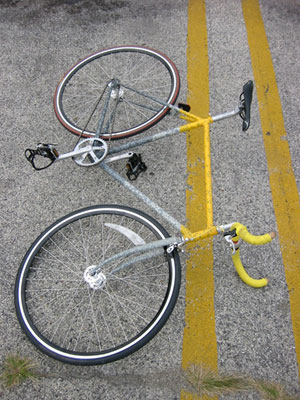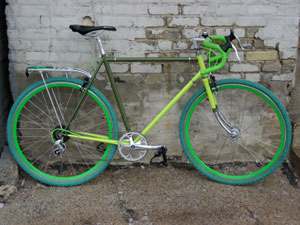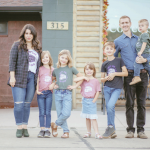More than just a ride

By Rebecca Cook
Photos by Harvey Opgenorth + Photo of Harvey by Rebecca Cook
Milwaukee artist Harvey Opgenorth looks to his surroundings for inspiration and the ever-present possibility of an art experience. A man with an eye for detail, Harvey constantly surveys his environment, savoring details as simple as a crack in the sidewalk. Examining the everyday objects that many of us take for granted has moved him to artistically explore fresh ways of presenting these objects. The result causes the viewer to pause and reconsider; Harvey challenges traditional perception. Over the last few years, he’s plumbed the possibilities of the art inherent in the design and use of bicycles. It started with a fixed gear; it was love at first sight. The attraction lay in the simplicity and utilitarian nature of the bike. It represented a convergence of form and function that fascinated Harvey. It also provided another outlet for his creative impulses. In honor of Bike to Work Week, Harvey sat down with me to talk about the role bikes play in daily life.
VS: Do you remember your first bike?
HO: Definitely. It was a blue bike with a yellow plastic seat and chrome fenders.
I think it was a Sears Special. I remember always using my feet as breaks. There is actually Super 8 footage on me riding that bike!
VS: How many bikes do you have?
HO: Three. I have two fixed gears; one is my commuter and one is my track bike. The other is my multi-speed road bike.
 VS: Your background in painting and sculpture, no doubt, plays a significant role in the bikes you build. What’s your process?
VS: Your background in painting and sculpture, no doubt, plays a significant role in the bikes you build. What’s your process?
HO: With the first bike I built, I wanted a bike that was the dictionary definition of a bike. So when I was building this bike I had a very specific blueprint in my head of what a quintessential bike is to me and utilized that to build it. It was very simplified. There weren’t any logos … it was almost making a cartoon of itself. A good comparison would be to think of a tree. It’s probably an idealized tree in your head, and that is how I treated that project. Of course, the quintessential idea is different for everyone, and the process is different with every bike. For example, low-riders are primarily about aesthetics. It functions smoothly but is about the look. It’s not necessarily about getting from point A to point B quickly. Whereas the high-end racing bike is more about technological advances and the way it functions. The aesthetics are secondary. My personal interest with bikes and art is to find a good balance between both sides, to make the project well rounded. The bike, for me, needs to both function well and be easily maintained, but also have a pleasing aesthetic … basically making something that is timeless and built with quality versus a fad.
VS: Do you consider yourself a bike artist?
HO: No, I see myself as an artist who sees the bicycle as a creative medium. Commuting by bicycle is a slower form of transportation that allows you to actually see and absorb the things around you rather than zoom through them. You see … the way people take care of their homes and gardens and feel an appreciation for your neighborhood. This goes back to my basic goal of trying to pay attention to surroundings. People forget to be aware. That’s something I’m continually trying to work on myself.
VS: Are you just making bikes for yourself, or do you take commissions?
HO: It’s basically for myself, and the [bikes] I work on at Ben’s Cycles. At Ben’s, people come into the bike shop and are daunted by the number of choices. It’s hard for them to make decisions. But that is what the employees at Ben’s like to do to: find out how the customer wants to use the bike, what kind of riding they are going to be doing, and then help them narrow down the choices to what is going to make them happiest and best suits their needs.

VS: So in a sense, you are helping the customer realize their quintessential bike?
HO: Yeah.
VS: What is working at Ben’s Cycles like?
HO: It’s one of the most morally sound jobs I’ve had. I love that it encourages exercise and less dependence upon oil. Also, it’s a third generation family-owned store that’s been around for almost 80 years. The people there are very much a family. In terms of the work, I’ve learned there are no real standards because technology keeps changing. [It’s] a major challenge in repairing a bike because the part won’t be made anymore. But it forces you to use your ingenuity and sense of DIY to repair the bike. I get to see … the history and evolution of bicycles because of the different-era bikes that come in. It’s cool to see the progression and technology change.
VS: Earlier this year, you participated in a benefit show for the Bicycle Federation of Wisconsin. How did you become involved in this?
HO: Shea [Schachameyer, Project Coordinator for the Bike Federation] asked me to be part of the show. I made a couple of sculptures including a ten-foot long spoke and a reproduction of Marcel Duchamp’s famous bicycle wheel attached to a stool. BFW promotes things I believe in, like getting bicycle racks on buses, allowing people to bike over the Hoan bridge and expanding bike lanes.
VS: How will you be spending bike to work week?
HO: By extending bike to work week all year. [Laughs.]
Learn more about Bike to Work Week by visiting the Bicycle Federation of Wisconsin online. Or stop by Ben’s Cycle and say hi to Harvey.




















